Meeting 1st July
We were called back to Sheffield earlier than we thought we would be, various questions had arisen since last Thursday and it made sense for us to meet face to face. So we caught the train from Saxilby for a morning meeting.
Ken, Julia and Ricky were on hand to chat things through. Lots of research had been done over the week and one decision was needed asap. We had been wanting to have an Alde 3020 gas boiler along with a Bubble Stove with a back boiler. Our heating needs tend to be mainly covered by our solid fuel stove in the winter and we were wanting to be able to harness some of this energy to heat our bedroom. The Alde boiler would mainly be used to help take the edge off on spring and autumn evenings, or first thing. Ricky had chatted combining both systems through with the main man at Bubble and several engineers at Alde.
The overall consensus was yes it was possible, but very complicated, much better not to bother. The Bubble chap went into details of a system with gradually rising pipes (these would all have to be hidden behind the cabin sides), thermal storage to help bleed off the heat, pumps as you can’t have the boiler boiling in the stove. The Alde engineers at first were positive, then with more digging and another two conversations with engineers who understood the scenario it got more complicated. A special calorifier would be needed with four coils, one for the Alde boiler, 1 for the back boiler, 1 from the engine and 1 for the radiators, avoiding copper in the system too. All sorts of details were talked about, yes they could do what we’d asked but it would be another extra onto our budget. We needed to talk it over between us and give a decision before the end of the day as this would effect things next week.
Conversations turned to the urine tank below the floor. As space on Oleanna is tight this has to be below the floor, which would make it hard to lift out to empty. Ken a while ago had suggested having a larger tank with a built in pump to empty it which now seems like a good idea. We had asked for a manual back up should the pump fail. They would provide us with a second outlet on the gunnel which we’d be able to lower a hose from a hand pump. This all works for us.
Then the upgrading of the alternator and batteries was discussed instead of having travel power. Ken had been looking into Lithium Ion Batteries which work in a different way to wet cell ones.
Mick here:
In order to save a few thousand pounds we had decided not to have the Electrolux Travel Power system installed but instead spend a few hundred on an upgraded 24v 100 amp leisure alternator. On chatting to Ken about this he suggested looking at having Lithium ion batteries in the leisure bank instead of the usual lead acid bank. On paper this sounds like a good idea. Lithium batteries can be run down to over 80% discharged without causing damage to them unlike to maximum 50% of a lead acid. Lithiums also charge back to full charge much more quickly than lead acid. The other main benefit is that the life of them is up to 10 times longer than a lead acid. Of course the downside is the price, they are MUCH more expensive but because of their longevity they should work out cheaper over an expected 10 year life span. Trouble is we would have to pay now instead of over 10 years!
If we went for these then we would need a different MPPT controller for our solar panels, a much more expensive one, but Ricky was waiting to hear back from Victron to see if their inverter/charger could also double as a solar panel controller. They have also asked Beta whether the 100 amp alternator can be configured to output the slightly higher voltage that the lithiums need to charge.
We need to think about this more. Any comments from blog readers?
The problem with the positioning of the freezer has been overcome and it will be possible to have it in the dinette on runners.
In our galley we will have a stack of drawers. The original thought was to have Shaker fronts to cupboards and doors, but I am not so sure of this now because of the 5 drawers one above the other. A couple of other possibilities were talked about, so some more thought is needed there from us.
In our last meeting we had provided a plan of how we saw the lights and sockets working, we chatted them through with Ricky. We may have over done what we need, so they are going to come back to us with what they would suggest. Although I’m sure not many boaters need extra lighting over their dinette for model making. We’ll see what they come up with. The position of switches was also discussed, a look around the almost finished boat in the yard illustrated where would be good places for them.
We then headed to chat things over on board. The engine bay has been dried out and given a coat of immaculate white paint, not sure how long it’ll stay that way once we get hold of her!
Still in the engine bay water pipes for the heating have been slotted through into the cabin through the tubes. These are just visible in the picture above.
The other side of the bulk head and the pipes run down and into the bilge.
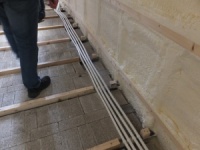
Here they run along a layer of ballast and across the cross members. Joists have now been added to these cross members and another layer of ballast added where needed.
There are gaps in the ballast. The above photo is where the bathroom will be. I think the two dark lines on the side indicate which cross members will need to be altered to accommodate the urine tank. One layer of ballast has been left clear towards the bow as this will be where our cupboards and bed will be, giving this side more weight.
The pipework on the starboard side is for water. One pipe heads to where the water tank will be, the other stopping short at the washing machine. On the port side the four pipes reduce in number once past the solid fuel stove.
Chris the carpenter joined us to discuss the positioning of panels on the cabin sides. These want to look considered, but with the positions of windows not identical on each side the panels will be different slightly. Also as I have more full height cupboards on one side this will also affect the look. But a solution was come up with that should look good.
“How big is the bathroom?” isn’t really the question you want to hear as people are clutching plans in their hands. But as they are still using the plans that I scanned back to front (on purpose) it is no wonder. Our bed which should be 1.5m wide had been read as 1.2m and this made our bathroom vast! It was then discovered that with the end bulk heads, my forgetting to add a bit of tolerance and a side panel to the washing machine the shower cubicle was getting very close to the bathroom porthole. An amendment was needed to rectify this.
I said we’d look at it and possibly a smaller washing machine as I re-drew the plans at the weekend. It had been worrying me that they were still using back to front plans which I could with some time rectify.
On the workshop floor was a large pile of oak slices along with some other darker wood on top. These will be used for the frame work of the panels. When we’d visited back in January we’d been shown a boat that had two different painted panels, oak and birch. The oak shows it’s grain where as the birch is less obvious. I preferred the birch so a sample will be put together for me to have a look at next time.
The plank and pole rack were obvious on the other boat, last time we were here we’d noticed that we had nothing on the roof, but a chrome version will be added to Oleanna at a much later date.
After our meeting we headed to the canal basin for some lunch, a fish finger sandwich and to discuss heating. We were both of the same opinion that spending the extra money and time to get a back boiler to work with the Alde boiler was not going to be worth it. We have survived two winters on board NB Lillyanne without a back boiler and we already know that Oleanna is better insulated. A shame not to be pushing the free heat from the solid fuel stove around, but we still have to think of the pounds. Our decision was emailed through to Julia and Ricky and I suspect the extra pipes for the back boiler were removed that afternoon.

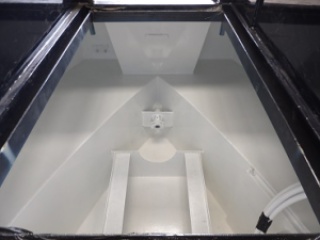
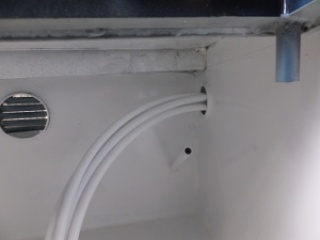
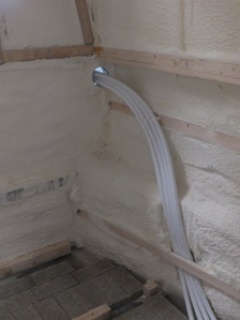


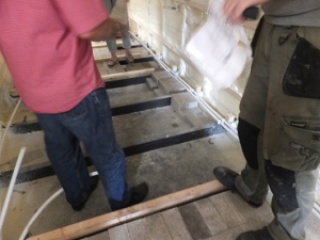


As far as I know, there are only two narrowboats with lithium batteries fitted, and I've reviewed both of them. They're the Boating Leisure Services boats which have won Crick the past two years. The BLS guys, and the owners of the boats, seem flabbergasted by the performance of the batteries. At Crick, they didn't run the engine for five days, and even with everything turned on the batteries were still on more than 50 per cent (although the solar panels helped). Both boats have a Beta 50 with twin 100A alternators to charge the batteries, but they can go from empty to full in about 45 minutes. The life of the batteries is expected to be much more than 10 years — more like 20 for a liveaboard, and possibly 30 for a leisure boater. I was told the whole system cost £15,000. It may be worth your while having a chat with Dave Flowers at BLS, as he's fitted two of these systems — and knows pretty much all there is to know about them.
Looking great you two, enjoying the build immensely. Think I Would of left the pipes in situ for possible future updates. Where is the stove on the boat? If it wasn't central I'd still be inclined to run some pipes in for a rad at the other end/bedroom or whatever it is. Difficult I guess with the rise in pipe work needed. Could do it after and in copper so you can spend your spare time polishing the copper pipes! ?Ade